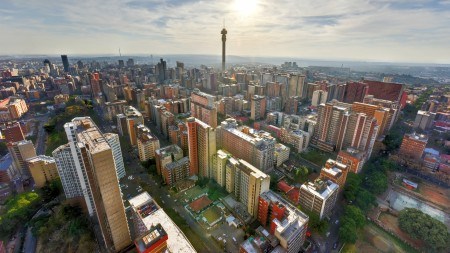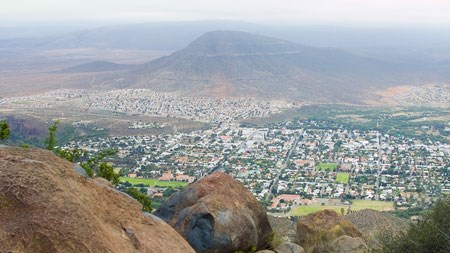Chat with the good folk of Constantia about their village [“suburb” is just too bourgeois] and one word consistently comes up in conversation. Gentle.
In Constantia, the pace of life is gentle. The walks are gentle. Even the climate is gentle. But of course it is. This is genteel country, where the landed gentry put down roots over 300 years ago, and where their descendants still dwell. Gentility covers Constantia like a veil of light mist all year round and it’s absolutely fabulous ... if you can afford to live there.
Among the Constantia properties being marketed by Pam Golding Properties is a four-bedroom home going for R45m, while Engel & Volkers is selling an “exclusive thatched residence” for a more modest R14m.
“Exclusive” is an apt adjective, as is “established” [read old money] and “elegant”. Mostly elegant; there are still a few “renovator’s dreams” out there, but you won’t pick up one for less than R3m – and then you’d need to spend another R3m on renovations before you would dare invite the neighbours over for tea... Not that “kuiering” is common in Constantia. Constantia resident Julie Stevens says that if there’s one criticism she has of Constantia it’s that there’s not much of a community vibe.
“In Constantia there are a lot of people living quiet lives behind high walls,” says Stevens. “You get the feeling like you’re in an exclusive bubble, separate from the rest of the city.” That exclusively recently came under threat when the provincial government announced plans to build lower- and middle-income housing on two sites near Constantia’s Uitsig wine estate. Constantia residents were incensed and they made it known. The NIMBY (not-in-my-back-yard) sentiment aside, you can see their point. Another N2 Gateway smack bang in the middle of the Constantia winelands isn’t likely to benefit anyone in the long run.
The controversy was enough to spur Constantia residents not only into talking to each other but into pulling together to put up a fight. And it was a good fight. The province has put the plans on hold.
“It really is a great place to live,” says Stevens. “There’s this gentle country feel and one is reminded of when life was slower and simpler. You get the sense of being close enough yet far away – out of the hustle and bustle. I find that I’m just 20 minutes from wherever I need to be.”
Residents revel in a lifestyle that invites you to pull on a pair of gumboots and go walking the network of greenbelts connecting the different parts of Constantia; to go jogging through the vineyards of the Groot Constantia Estate; or to picnic on the lawns.
“There are always people out walking with children and dogs and riding horses. And the access to the mountains and the beaches of Noordhoek or Hout Bay is unrivalled.”
Being the birthplace of the wine farming industry in South Africa, Constantia also has its very own little wine route which comprises five top-notch vineyards that consistently produce award-winning wines. The vineyards are: Constantia Uitsig, Groot Constantia, Klein Constantia, Buitenverwachting and Steenberg. Fine wine is synonymous with fine dining and Constantia has no shortage of highly rated restaurants. There’s Jonkershuis, Pastis Brasserie, Greens, River Café, Jakes, and The Cape Malay at Cellars-Hohenort – to name just a few.
Shopping in Constantia is also ... gentle. Constantia Village is a most civilised place to shop. There’s plenty parking and all a shopper really needs: Woolworths (food store), PicknPay, a pharmacy, Exclusive Books, Red Square, boutiques and Melissa’s deli. If you can’t find what you’re looking for at Constantia Village, Cavendish in Claremont is just up the drag.
The one thing Constantia doesn’t have is a good selection of schools. If you’re looking for a private school there’s just the Waldorf School and Reddam House (in Tokai). This can be a problem for young families, though Constantia apparently doesn’t have too many of those.
According to Lightstone property analysts, fewer than 10% of recent buyers in Constantia are aged between 18 and 35. Most buyers (45%) in the area are aged 50-64 – and unlikely to be parenting young children.
To cater for Constantia families, Bishops operates a bus service ferrying learners between the exclusive boys’ school and the leafy suburb.
When Cedric Beyer bought in Constantia, his timing couldn’t have been better. It was 1993 just before elections and fear had taken hold of the market. Expecting land invasions and the like, many packed up for Perth, selling their houses for a song. Beyer picked up his four-bedroom home (with study and two lounges) for the bargain price of R530k. Today, without having made any improvements, it is worth R4m. Certainly, you can’t go wrong buying in Constantia. According to Lightstone, Constantia is ranked 16th (out of 5 182 suburbs nationally) in terms of mean valuation. Property in Constantia will always be sought-after. Over the past 12 months, there were 83 sales in Constantia, the average price of a house being R5.9m. Beyer says he took a bit of a gamble buying his house, which is close to transport and borders on a greenbelt with a stream: “basically a squatter’s dream”. Thankfully there were no land invasions and buying alongside a greenbelt has paid off. Not only is the birdlife beautiful, but the greenbelt itself is now lovelier than ever. “When I bought it was quite overgrown. But it has since been cleared of alien vegetation and it’s very well maintained.” In the 16 years that Beyer has lived in Constantia little has changed. “The atmosphere is still very rural; it’s quiet and we still don’t have street lights.” There has been only one notable change to the neighbourhood and that’s the walls. “Over the years, properties that used to roll out onto the road are now surrounded by high walls.” As the saying goes, “A man’s home is his castle”. And what’s a castle without walls?




